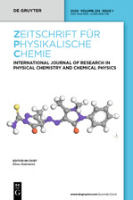
ZEITSCHRIFT FUR PHYSIKALISCHE CHEMIE-INTERNATIONAL JOURNAL OF RESEARCH IN PHYSICAL CHEMISTRY & CHEMICAL PHYSICS
Scope & Guideline
Innovating Research in Chemical Physics
Introduction
Aims and Scopes
- Nanomaterials and Nanocomposites:
Research on the synthesis, characterization, and application of nanomaterials, particularly focusing on their photocatalytic, electrochemical, and antibacterial properties. This includes studies on metal oxides, graphene-based materials, and hybrid composites. - Photocatalysis and Environmental Remediation:
Investigations into photocatalytic processes for environmental cleanup, including the degradation of organic pollutants and dyes in wastewater. This area often employs advanced materials and innovative synthesis techniques. - Electrochemistry and Energy Storage:
Exploration of electrochemical systems, including supercapacitors and batteries, focusing on material development, performance enhancement, and efficiency improvements. - Theoretical and Computational Chemistry:
Utilization of computational methods to study molecular interactions, thermodynamic properties, and the design of new materials, often complemented by experimental validation. - Green Chemistry and Sustainable Practices:
Research emphasizing eco-friendly synthesis methods and the use of renewable resources for the development of materials, aimed at reducing environmental impact. - Biomaterials and Biomedical Applications:
Studies on the application of chemical materials in biomedical fields, including drug delivery systems, biosensors, and antimicrobial agents.
Trending and Emerging
- Sustainable and Green Chemistry:
There is a marked increase in research focused on sustainable practices, including the development of green synthesis methods and the utilization of renewable resources for material production. - Advanced Nanotechnology:
The journal has seen a surge in studies related to nanotechnology, particularly the design and application of nanocomposites in various fields, including environmental remediation and energy storage. - Interdisciplinary Approaches:
Emerging trends highlight the integration of physical chemistry with biological sciences, materials science, and engineering, focusing on the development of multifunctional materials for biomedical applications. - Machine Learning and Computational Modeling:
The use of machine learning and advanced computational modeling techniques in predicting material properties and behaviors is gaining traction, reflecting a modern approach to research in physical chemistry. - Environmental Chemistry:
A growing emphasis on environmental chemistry, particularly in relation to pollutant degradation and the development of sustainable technologies for water purification and waste management.
Declining or Waning
- Traditional Organic Chemistry:
Research focusing solely on classical organic reaction mechanisms and synthetic methodologies has decreased, with a shift toward more interdisciplinary approaches that integrate physical chemistry with materials science and nanotechnology. - Inorganic Chemistry without Application Context:
Studies that purely focus on the synthesis and characterization of inorganic compounds without exploring their applications, particularly in catalysis or materials science, appear less frequently. - Single-Component Systems:
The exploration of simple, single-component systems in physical chemistry has waned, as there is a growing preference for complex, multi-component systems that provide more relevant insights into real-world applications. - Basic Thermodynamics:
Research articles focused on basic thermodynamic principles without application to modern challenges, such as energy storage or environmental issues, are becoming less common.
Similar Journals
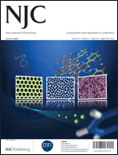
NEW JOURNAL OF CHEMISTRY
Elevating Knowledge in Chemistry and BeyondNEW JOURNAL OF CHEMISTRY, published by the prestigious Royal Society of Chemistry, serves as a vital platform for the dissemination of research in the dynamic fields of chemistry, catalysis, and materials science. With an impressive ISSN of 1144-0546, this journal boasts a rich history, having been established in 1996, and is set to continue its impactful publication through 2024. The journal is recognized in several categories, achieving a Q2 ranking in both chemistry and materials chemistry, and a Q3 rank in catalysis, reflecting its significance within these disciplines. Researchers will find it particularly noteworthy that the journal holds an esteemed position in the Scopus rankings, with a 65th percentile standing in general chemistry. Though it currently operates on a subscription model, its commitment to advancing the frontiers of chemistry makes it an essential resource for academics, professionals, and students seeking to keep abreast of the latest advancements and innovative methodologies in their fields.

PROGRESS IN CHEMISTRY
Fostering Collaboration in Chemical ResearchPROGRESS IN CHEMISTRY is a distinguished journal within the field of chemistry, published by the Chinese Academy of Sciences. With an ISSN of 1005-281X and an E-ISSN of 1005-281X, this journal has served as an essential platform for the dissemination of innovative research since its inception in 1997. Operating under the esteemed reputation of its publisher, PROGRESS IN CHEMISTRY is classified in the Q3 quartile for Chemistry (miscellaneous) in 2023, highlighting its ongoing contribution to the scientific community. Although the journal is not available as an open access publication, it maintains a commitment to high-quality peer-reviewed content that supports the advancement of chemical sciences. It caters to a diverse audience ranging from researchers and professionals to students, providing insights and fostering collaborations in various sub-disciplines of chemistry. With a convergence period spanning from 1997 to 2024, PROGRESS IN CHEMISTRY is an invaluable resource for those seeking to stay at the forefront of chemical research developments.
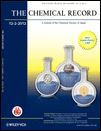
CHEMICAL RECORD
Exploring the Frontiers of Chemical KnowledgeThe Chemical Record is a prestigious peer-reviewed journal published by WILEY-V C H VERLAG GMBH, focusing on innovative research and developments across the diverse and evolving fields of chemistry and biochemistry. With an esteemed 2023 Impact Factor and recognized as a Q1 journal in several categories—including Biochemistry, Chemical Engineering, and Materials Chemistry—The Chemical Record stands as a critical resource for researchers, professionals, and students aiming to disseminate and acquire knowledge in these disciplines. The journal's engaging scope covers contemporary topics and fosters collaboration within the global scientific community, ensuring accessibility to cutting-edge research. By publishing articles that meet the highest standards of scholarship, it has earned a significant place within the academic ecosystem, as reflected in its strong Scopus rankings. Although The Chemical Record operates without open access, it remains deeply committed to advancing the field of chemistry through rigorous and impactful publications that bridge gaps between theory and practice.
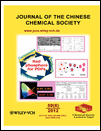
JOURNAL OF THE CHINESE CHEMICAL SOCIETY
Exploring the Frontiers of Chemical ScienceJOURNAL OF THE CHINESE CHEMICAL SOCIETY, published by WILEY-V C H VERLAG GMBH, is a vital resource in the field of chemistry, focusing on a broad array of topics pertinent to general chemistry and its advancing sub-disciplines. Established in 1954 and running through 2024, this journal serves as a significant platform for the dissemination of high-quality research, showcasing innovative findings and developments within the chemical sciences. With its Q3 category ranking and positioning at Rank #203 in General Chemistry per Scopus, it reflects the journal's commitment to research excellence and impact. While not an open-access publication, it ensures accessibility to a global audience, making it an essential tool for researchers, professionals, and students alike seeking to stay informed and engaged in the evolving landscape of chemistry.

JOURNAL OF CLUSTER SCIENCE
Pioneering Research in the Heart of Materials ScienceJOURNAL OF CLUSTER SCIENCE, published by SPRINGER/PLENUM PUBLISHERS, is a prominent and influential journal in the fields of Biochemistry, Chemistry, Condensed Matter Physics, and Materials Science. With an ISSN of 1040-7278 and E-ISSN of 1572-8862, this journal has been contributing to scientific discourse since its inception in 1990 and continues to publish cutting-edge research through 2024. It holds a respectable position in the academic landscape with its category quartiles indicating a Q3 ranking in Biochemistry and Q2 rankings in Chemistry, Condensed Matter Physics, and Materials Science as of 2023. The journal's noteworthy Scopus rankings further underscore its relevance, particularly a rank of #82 in Condensed Matter Physics, showcasing its impact and the quality of research disseminated. Although it does not currently offer open access options, it remains a key resource for researchers, professionals, and students who are invested in understanding the complexities of cluster science and its interdisciplinary applications.

Journal of Inorganic and Organometallic Polymers and Materials
Exploring Innovations in Materials Science and Polymer ChemistryThe Journal of Inorganic and Organometallic Polymers and Materials, published by SPRINGER, is a premier academic journal dedicated to advancing the field of materials science, particularly in the domains of inorganic and organometallic polymers. Established in 1996, this journal has successfully converged multiple years of research, reflecting the dynamic evolution of the field through to 2024. With an impressive Scopus Rank placing it in the top 81st percentile in both Materials Chemistry and Polymers and Plastics, it is recognized for its significant contributions and innovations. The journal is classified in the prestigious Q2 Category, indicating its influence and relevance among leading publications. While it operates under a subscription model, the journal is committed to disseminating cutting-edge research, providing insights that empower researchers, professionals, and students to push the boundaries of materials chemistry and polymer science. Its focus on high-quality, peer-reviewed articles ensures that readers are equipped with the latest findings and methodologies that drive this exciting and rapidly evolving field.
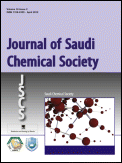
Journal of Saudi Chemical Society
Catalyzing Progress in the World of Chemistry.The Journal of Saudi Chemical Society, published by ELSEVIER, stands as a premier platform for advancing knowledge in the field of chemistry. Since its inception in 2009, this Open Access journal has garnered significant attention, securing a prestigious Q1 ranking in the Chemistry (miscellaneous) category for 2023, reflecting its position among the top journals in the discipline. With an impressive Scopus ranking of #66 out of 408 in General Chemistry, this journal boasts a commendable 83rd percentile, underscoring its impact and relevance in the global research community. The journal aims to disseminate high-quality research articles, reviews, and case studies, fostering innovation and collaboration among chemists and allied professionals. By enabling widespread access to cutting-edge research, the Journal of Saudi Chemical Society plays a crucial role in supporting the educational and professional development of students, researchers, and practitioners alike, making it an essential resource for anyone invested in the dynamic field of chemistry.
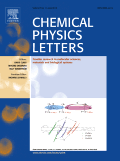
CHEMICAL PHYSICS LETTERS
Delivering High-Impact Discoveries in Chemical PhysicsCHEMICAL PHYSICS LETTERS, published by Elsevier, is a prestigious journal that has been at the forefront of advancing knowledge in the fields of physical and theoretical chemistry and physics since its inception in 1967. With an impressive impact factor reflective of its high-quality research output, this journal holds Q2 quartile rankings in both the Physical and Theoretical Chemistry and Physics and Astronomy categories for 2023. It is recognized as a key platform for disseminating groundbreaking findings, with Scopus rankings placing it within the top 76th and 66th percentiles in its respective categories. Researchers and professionals benefit from its insightful contributions and rigorous peer-review process, making it an essential resource for those engaged in cutting-edge chemical physics studies. Although the journal is not open access, it remains accessible through various institutional subscriptions, ensuring that a wide audience can explore its wealth of knowledge. Located in Amsterdam, Netherlands, the journal continues to drive innovation and collaboration across diverse scientific disciplines.
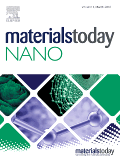
Materials Today Nano
Exploring Innovations in Nano-Science and EngineeringMaterials Today Nano, published by Elsevier, is a premier academic journal dedicated to the forefront of nano-materials research, encompassing innovations and advancements in biomaterials, condensed matter physics, electronic, optical, and magnetic materials, as well as materials chemistry. With an impressive Q1 ranking across multiple categories, including biomaterials and materials chemistry, this journal serves as a essential platform for researchers, professionals, and students aiming to contribute to and stay informed on cutting-edge developments that push the boundaries of materials science. Its open access model allows for wider dissemination of high-impact findings, ensuring that the research reaches a global audience. Operating from the United Kingdom, Materials Today Nano plays a vital role in fostering interdisciplinary collaboration and advancing scientific understanding in this rapidly evolving field.
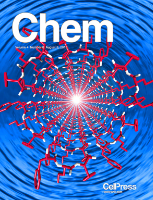
Chem
Advancing the Frontiers of Chemical ResearchChem, published by CELL PRESS, is a renowned academic journal that has rapidly established itself as a leading platform for cutting-edge research in diverse areas such as biochemistry, chemical engineering, materials chemistry, and environmental chemistry. Released under the ISSN 2451-9294, this esteemed journal has achieved an impressive Q1 category ranking across multiple disciplines in 2023, highlighting its significant impact and prominence within the academic community. With a strong focus on innovative studies and interdisciplinary approaches, Chem fosters a vibrant dialogue among researchers, professionals, and students, making it an indispensable resource for those seeking to advance their knowledge and contribute to the evolving field of chemistry. As an open access journal, it aims to democratize knowledge, ensuring that critical research is accessible to a global audience. With its headquarters based in Cambridge, MA, it continues to lead the charge in the dissemination of pivotal findings that shape our understanding of chemical sciences.